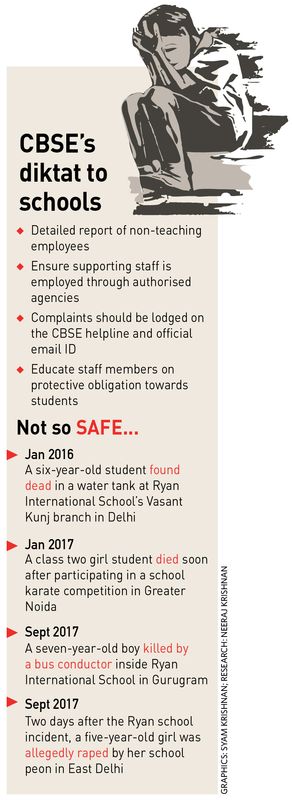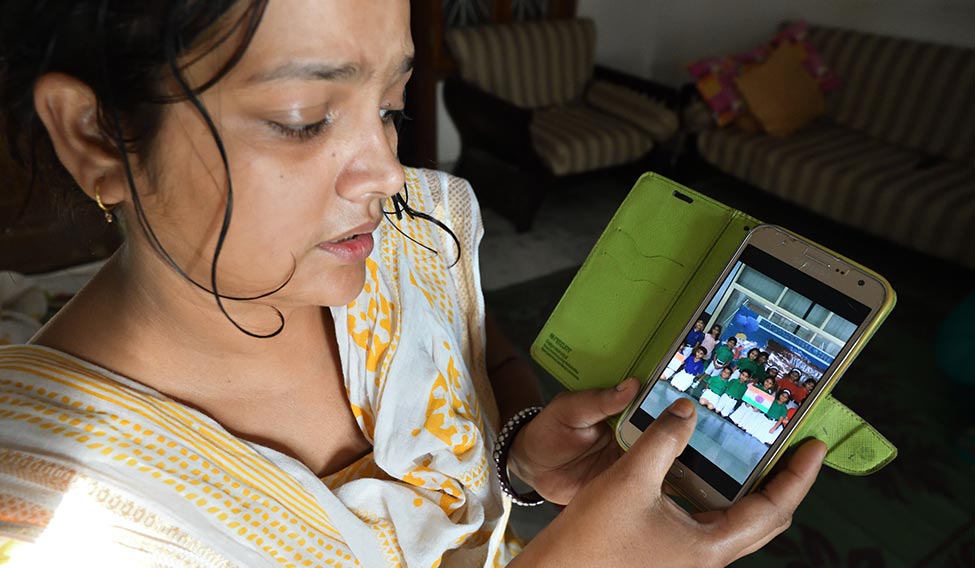On September 8, at about 8 in the morning, Barun Chandra Thakur dropped Pradhyumn, seven, at Ryan International School in Gurugram. He waved goodbye to his son, unaware that it would be for the last time. About 15 minutes later, Thakur’s phone rang; it was the school. He was told that his son had been “severely cut” and was “bleeding profusely”, and that he should reach Artemis Hospitals in Gurugram immediately.
“When we reached, my child was in the emergency. I saw a deep cut on his right side, from ear to throat, and there was blood all over him. The hospital told me he was brought dead,” the bereaved father told THE WEEK. “The world stopped for me… my son died 10 to 15 minutes after I dropped him off at the school gate.” His wife, Jyoti, is inconsolable and his 11-year-old daughter, Vidhi, is in shock. The hapless father said he failed his family and his son. “I don’t know how to live… a life without my kid,” he said.
Pradhyumn was caught on security camera crawling out of a school toilet, holding his neck. A school bus conductor, who was filmed coming out of the toilet, was later arrested. A postmortem report said the boy had died minutes after his throat was slit.

To get justice for Pradhyumn and to “save thousands of parents from suffering” like him, Thakur moved the Supreme Court on September 11, seeking strict safety guidelines and accountability from schools. Read his emotional writ petition: “The collective conscience of the whole nation has been shaken because of the recent and continuous incidents.... Today, they [parents] are in fear whether or not to send their children to schools. They fear whether the child would return in the same manner... [or] return at all.”
The Supreme Court later sought replies from the Central and Haryana governments on Thakur’s petition.
The father’s appeal finds resonance in households across India. Pradhyumn’s case lays bare the gaps in school safety systems and highlights the swelling number of crimes against children in India. The Ryan case is not an exception. More than a dozen gruesome cases have come to light in 2017, five of them in September. According to the National Crime Records Bureau, at least 258 cases of crime against children were reported every day in 2015; there were 94,172 cases that year. The bureau does not specify the number of such crimes happening in schools, but with 98 per cent of children having access to schools, one cannot ignore the safety concerns of parents.
“The recent incidents in cities such as Delhi, Gurugram and Bengaluru are chilling. When you send your daughter or son to a good school and pay hefty fees, you expect the school to be more concerned about the child. You want the children to stay alive, education is secondary,” says Varun Bhojwani, a Mumbai-based executive whose daughter studies in class two. Bhojwani said he and his wife had mutually decided that she would take a break from work to take care of the daughter.
But, why are cases of child abuse on the rise? “Children become easy targets as they are more vulnerable and start trusting people easily,” says Amit Sen, director of Children First, a mental health institute in Delhi. “Creating awareness among parents, students and school staff is paramount. There should also be swift punitive action against those violating rules and abusing kids.”
According to a 2016 global study by ChildFund Alliance, an international non-profit organisation, one in three children in India feels his school is only “sometimes” safe. In the study, Indian students defined school safety as having a safe building with proper security measures and with protection from strangers. They also wanted proper supervision by teachers.
Following the Ryan school incident, the Central Board of Secondary Education has issued a safety circular to all its schools holding them “solely” responsible for safety requirements. It has laid down a set of rules that schools need to follow (see graphics). However, in India, there is never a shortage of rules or laws, the problem is poor implementation or circumvention of the laws. Point in case—there was a liquor shop within 25 metres of Ryan International School.
On September 18, after Women and Child Development Minister Maneka Gandhi and Human Resource Development Minister Prakash Javadekar met to review school safety concerns, it was announced that the CBSE, NCERT and the National Commission for Protection of Child Rights would work together to devise new safety norms. NCERT would also popularise safety awareness through its books and schools would be asked to hire more female staff.
“The Ryan case is a definite case of security lapse,” said Nivedita Haldhar, a teacher at Patna’s St. Joseph’s Convent High School. “Schools cannot shirk their responsibility of providing safety to students, but parents need to make their children aware about the dangers as well. If all the stakeholders work together, we can provide a secure environment to every child in a school.”
Meanwhile, gauging the growing apprehension among parents, several schools have issued circulars underlining the security measures they have taken or will take. In a letter to parents, GD Goenka Public School in Gurugram wrote that it had 350 CCTV cameras and that all its employees had undergone police verification. Read the letter: “Safety and security don’t just happen, they are the result of collective consensus and team effort…. In a time like this, where the recent incidents have grieved and moved everyone, we have come together and give assurance to our children.”







